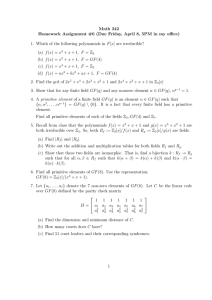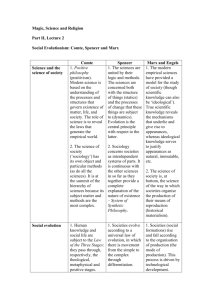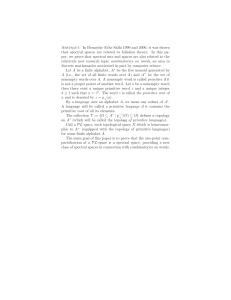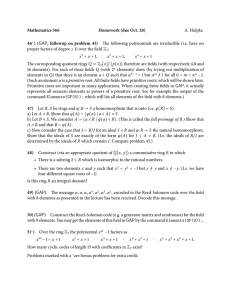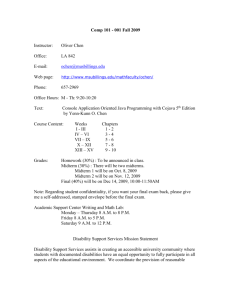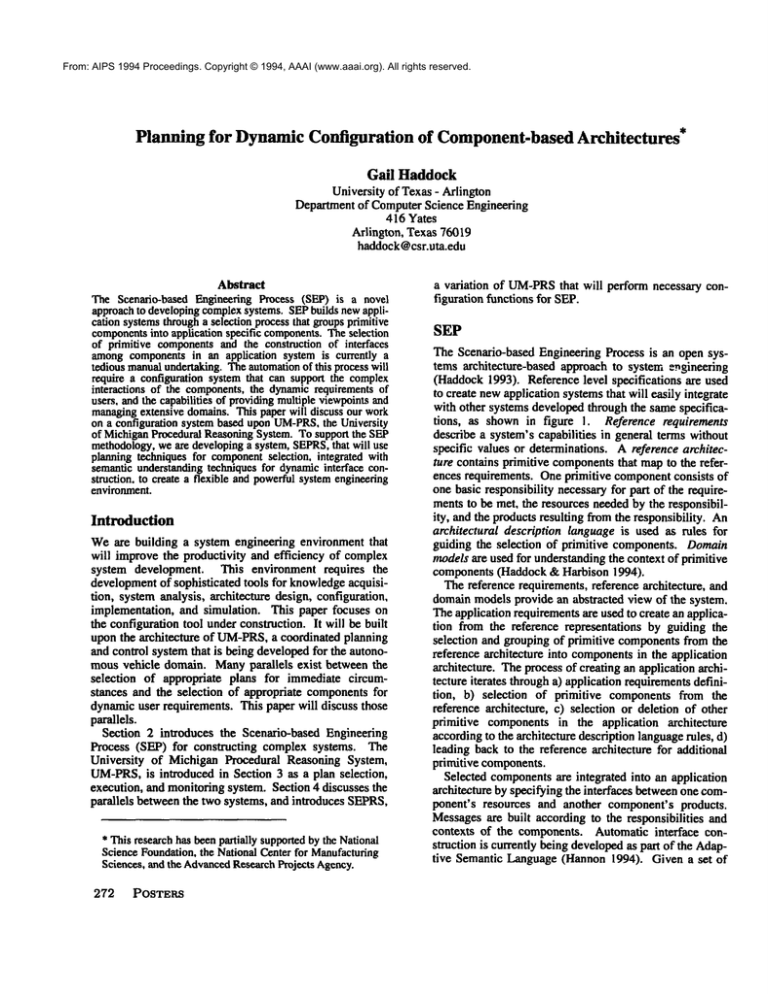
From: AIPS 1994 Proceedings. Copyright © 1994, AAAI (www.aaai.org). All rights reserved.
Planning for Dynamic Configuration of Component-based Architectures*
Gail Haddock
University of Texas - Arlington
Department of ComputerScience Engineering
416 Yates
Arlington, Texas 76019
haddock@csr.uta.edu
Abstract
The Scenario-based Engineering Process (SEP) is a novel
approachto developingcomplexsystems. SEPbuilds newapplication systemsthrougha selection processthat groupsprimitive
components
into application specific components.Theselection
of primitive componentsand the construction of interfaces
amongcomponentsin an application system is currently a
tedious manualundertaking.Theautomationof this processwill
require a configuration systemthat can support the complex
interactions of the components,the dynamicrequirementsof
users, and the capabilities of providingmultiple viewpointsand
managingextensive domains.This paper will discuss our work
on a configuration systembased uponUM-PRS,
the University
of MichiganProcedural ReasoningSystem.To support the SEP
methodology,weare developinga system, SEFRS,that will use
planning techniquesfor componentselection, integrated with
semantic understandingtechniquesfor dynamicinterface construction, to create a flexible and powerfulsystemengineering
environment.
Introduction
Weare building a system engineering environment that
will improve the productivity and efficiency of complex
system development. This environment requires the
developmentof sophisticated tools for knowledgeacquisition, system analysis, architecture design, configuration,
implementation, and simulation. This paper focuses on
the configuration tool under construction. It will be built
upon the architecture of UM-PRS,
a coordinated planning
and control systemthat is being developedfor the autonomous vehicle domain. Manyparallels exist between the
selection of appropriate plans for immediate circumstances and the selection of appropriate componentsfor
dynamicuser requirements. This paper will discuss those
parallels.
Section 2 introduces the Scenario-based Engineering
Process (SEP) for constructing complex systems. The
University of Michigan Procedural Reasoning System,
UM-PRS,
is introduced in Section 3 as a plan selection,
execution, and monitoring system. Section 4 discusses the
parallels betweenthe two systems, and introduces SEPRS,
* This researchhas beenpartially supportedby the National
ScienceFoundation,the National Center for Manufacturing
Sciences, and the Advanced
ResearchProjects Agency.
272
POSTERS
a variation of UM-PRS
that will perform necessary configuration functions for SEP.
SEP
The Scenario-based Engineering Process is an open systems architecture-based approach to system e.ngineering
(Haddock1993). Reference level specifications are used
to create newapplication systems that will easily integrate
with other systems developedthrough the same specifications, as shown in figure I. Reference requirements
describe a system’s capabilities in general terms without
specific values or determinations. A reference architecture contains primitive componentsthat mapto the references requirements. One primitive componentconsists of
one basic responsibility necessaryfor part of the requirements to be met, the resources needed by the responsibility, and the products resulting fromthe responsibility. An
architectural description language is used as rules for
guiding the selection of primitive components. Domain
modelsare used for understanding the context of primitive
components (Haddock & Harbison 1994).
The reference requirements, reference architecture, and
domainmodelsprovide an abstracted view of the system.
The application requirementsare used to create an application from the reference representations by guiding the
selection and grouping of primitive componentsfrom the
reference architecture into componentsin the application
architecture. The process of creating an application architecture iterates througha) application requirementsdefinition, b) selection of primitive components from the
reference architecture, c) selection or deletion of other
primitive components in the application architecture
accordingto the architecture description languagerules, d)
leading back to the reference architecture for additional
primitive components.
Selected componentsare integrated into an application
architecture by specifying the interfaces betweenone component’s resources and another component’s products.
Messagesare built according to the responsibilities and
contexts of the components. Automatic interface construction is currently being developedas part of the Adaptive Semantic Language (Harmon1994). Given a set
From: AIPS 1994 Proceedings. Copyright © 1994, AAAI (www.aaai.org). All rights reserved.
Scenario-based Engineering Process
¯ ¯ ~ ~hc~ion
A~t~on,
’
A~i~¢um
[ Requ,rements
I
Selct ....
~1
Create....
,- Platfoml
i
|
|
Re
,~,yaqt
deve/opedsd~are
sysmm
profile
Figure
1
UM-PP,S
components and a new componentto be added to the set,
the Adaptive SemanticLanguagewill create the interfaces
and messages necessary for the new component to
communicatewith the existing set. This is done using
modified human language understanding techniques,
retaining the rich semantics of humanlanguage while limiting the ambiguity.
Once the application architecture is determined, the
application system is developed by separate organizations
taking responsibifity for building various components.
Design requirements, standards, profiles, and computational models are used to complete the system using the
application architecture as a guide. Thus, an organization
can focus on areas in whichthey excel, confident that their
product will interface with products from other organizations and together create a successful system.
SEPis has been used to develop specifications for the
Next Generation Controller project funded by the National
Center for ManufacturingSciences. It is also being used
in the Trauma Care Information Management System
project funded by the Advanced Research Projects
Agency. Both projects are lead by Dr. Karan Harbison at
the University of Texas- Arlington.
The University of Michigan Procedural Reasoning System, UM-PRS
(Lee et al. ! 993), a C++implementation
PRS(Georgeff &Lansky, 1990), is a reactive system and
not a typical planning system, see figure 2. Rather than
determine a path from a goal back to a present state by an
ordered application of operators, UM-PRS
assumes these
types of plans already exist. Its strength is in its determination of when to use which plan in a rapidly changing
execution environment. A belief area is used to hold a
representation of the environment. Knowledgeareas (KA)
contain previously built plans along with their purpose and
context. A set of knowledgeareas is selected as being pertinent to the current world modeland is maintainedby the
intention structure. Goals are used to guide the system’s
actions. Aninterpreter controls the system’sactivities.
UM-PRSis currently being used in the autonomous
vehicle domain. Its ability to continually consider the
real-time dynamic environment and access plans accordingly fits well into military applications, whereplans have
already been generated in the form of standing operating
procedures and reactions to the quickly changing environment are paramount. Our SEP domain does not require
the hard real-time speed of a reactionary system. How-
UM-PRSSystem Structure
I MonitorI
~"
KAPlans I
1’
~
I Belie~s
I Sensor
I
I,
~nvironment
Inteqxeter
I
Goals
IntentionI
s ura L,
I
I Ef ctorI
’1’
C°m
nd
IGenerator
Figure 2
HADDOCK 273
From: AIPS 1994 Proceedings. Copyright © 1994, AAAI (www.aaai.org). All rights reserved.
SEPRSSystem Structure
new
/~ Reference
respons~ilities Architecture
I
user
moomcatlons
Interpmter
J Application.
]
,~ Hequlremenis
Figure3
ever, muchof the UM-PRS
architecture maps readily to
the configuration problem in the SUPdomain.
SEPRS
The Scenario-based Engineering Procedural Reasoning
System, SEPRS,will use the architecture of UM-PRS
to
implementa configuration system for SUP,shownin figure 3. Primitive componentsof the reference architecture
will take the place of knowledgearea plans, as each primitive componentis a responsibility that has its ownsubresponsibilities, resource requirements, and product interfaces. The architecture description language will also
reside in the reference architecture area, as it contains
rules associated with the primitive components.The goals
will be replaced by reference/application requirements.
The interpreter will use the application requirements as
goals to satisfy through access to the reference architecture. Componentspreviously formed into an application
architecture in-progress will be in the beliefs area. They
are accessed by the interpreter to determine which goals
are not yet satisfied. Theinterpreter will activate relevant
primitive componentsthat are maintained by the intention
structure. The intention structure will release chosen
primitive components to the component integrator. The
component integrator will employ Adaptive Semantic
Languagetechniques to build the interfaces and messages
necessary for adding the primitive componentto the application architecture.
The grouping of primitive componentsinto components
remains a manualtask, as this grouping can be done from
a variety of viewpoints. For example, some groupings
may be clone for marketing purposes. Other groupings
mayindicate the assignment of construction of the component to various organizations. The environment area of
UM-PRS
then becomesour system engineer, directing the
grouping process. The system engineer’s modifications
are added back to SEPRSthrough a component monitor,
who sends the component determinations into the inprogress area, thus completingthe cycle.
Building the SUPconfiguration system on the SEPRS
architecture supports more than the componentselection
process. Modifications to the application requirements are
also supported. Since requirements are maintained in the
274
POSTERS
goals area and are continually accessed by the interpreter,
user modifications can be interjected at any point in the
architecture creation cycle. These modifications may
immediately cause primitive componentsto be deselected
and their interfaces disconnected, which maythen require
an extensive reconfiguration of the architecture. The
SEPRS
architecture also supports the expansionof the reference architecture. As newtechnologies arc invented that
result in newresponsibilities, those responsibilities can be
addedthroughthe reference architecture area.
Conclusion
Weare building a configuration system, SEPRS,for component-based architecture methodologies by adapting the
UM-PRS
planning system. Weexpect it to fit well in our
system engineering environment that includes scenario
modeling,object-oriented analysis and design, and simulation systems. These systems will be interconnected
through the Yellow Rose, a LOOM-based
semantic network kernel that allows systems to share information on
an application under development. Workon SEPRSand
the YellowRoseis continuing.
References
Georgeff, M. and Lansky, A. 1990. Reactive Reasoningand
Planning.Allen,J., Hendler,J., and"Fate,A., eds., Readings
in
Planning, San Mateo, Ca: MorganKanfmann.
Haddock,G. 1993. The Scenario-basedEngineeringProcess: A
Lifecycle Incorporating Formalisms,Methodologies,and
Toolsinto Domain
Specific SoftwareArchitectures. Master’s
thesis, Dept. of Computer
ScienceEngineering,Universityof
Texasat Arlington.
Haddock,G., and Harbison,K. 1994. FromScenariosto Domain
Models;Processes and Representations. In Proceedingof
Knowledge-based
Artificial Intelligence Systemsin Aerospaceand Industry. Bellingham,
Wa:InternationalSocietyfor
Optical Engineering.
Harmon,C. 1994. Ann-TowersModelfor the Knowledge
Representation of an AdaptiveSemantic’Language.Master’sthesis,
Dept. of ComputerScienceEngineering.University of Texas
at Arlington.
Lee, J., Huber, M., Durfee, E., Kenny,P. 1993. UM-PRS:
An
Implementation
of the ProceduralReasoningSystem.Technical Report,Universityof Michigan



